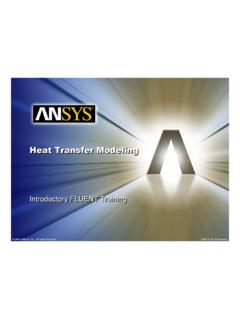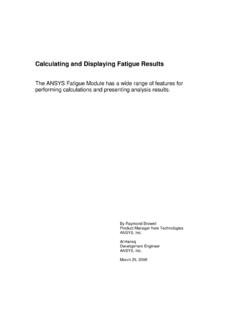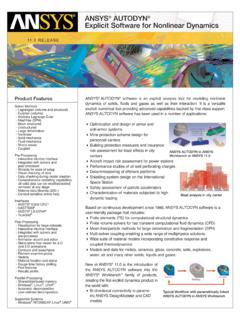Transcription of AN INTRODUCTORY ANSYS TUTORIAL: SOLVING A …
1 AN INTRODUCTORY ANSYS TUTORIAL: SOLVING A. STATIC TRUSS PROBLEM. Rajesh Bhaskaran Cornell University E-mail: This is a quick-and-dirty INTRODUCTORY tutorial to the ANSYS software package that details how to solve a simple static truss problem. ANSYS is a finite-element analysis package used widely in the industry to simulate the response of a physical system to structural loading, and thermal and electromagnetic effects. ANSYS uses the finite-element method to solve the underlying governing equations and the associated problem-specific boundary conditions. No previous knowledge of ANSYS is assumed in this tutorial. As you go through the tutorial, mark suggested changes and problems, and hand in a description of what you learned. The tutorial is followed by two problem sets. Record and submit how much time you spent on the tutorial and each of the problem sets. Problem Specification Determine the force in each member of the following truss.
2 Indicate if the member is in tension or compression. The cross-sectional area of each member is m and the Young's modulus is N/m . m A. B. m F= kN. m y x C. Figure 1: Geometry of the truss. Solution Steps 1. Start-up and preliminary set-up 2. Specify element type and constants 1. 3. Specify material properties 4. Create nodes 5. Create elements from nodes 6. Specify boundary conditions 7. Solve! 8. Analyze the solution Let's go through these steps now. Start-Up and Preliminary Set-Up ANSYS is available at the ACCEL computer lab on the second floor of Carpenter Hall. To get to ACCEL, go past the circulation desk of the Engineering library and take the stairs to your left. Log into Windows at the ACCEL facility. If you don't have an account, follow the instructions on the screen to create an account. ANSYS needs a directory into which it can save files during the session. Start NT Explorer from the desktop and create a folder called ANSYS on the S: drive.
3 Minimize the NT Explorer window. At ACCEL, the S: drive puts you in your home directory which is saved from session to session and can be accessed from any machine at ACCEL. To start ANSYS , click on Start Programs ANSYS Interactive In the window that pops up, enter S: ANSYS as your working directory. This is the directory to which ANSYS will write files. Specify truss as your Initial jobname. The jobname is the prefix used for all files generated by the ANSYS . run. Click on Run. This brings up the following windows: ANSYS /University High Option Utility Menu: This is referred to simply as the Utility Menu. Note that the jobname truss appears in parenthesis in the title bar of the Utility Menu. ANSYS Main Menu ANSYS Graphics ANSYS Toolbar: This contains shortcuts to often-used commands and can be customized. ANSYS Output Window (which might be hidden behind the others): This is the window to which output is written by default and provides feedback on the actions taken by ANSYS as you navigate the menus.
4 We'll more or less work our way down the Main Menu. In the Main Menu, click on the Preferences button. In the Preferences for GUI Filtering dialog box, click on the box next to Structural so that a tick mark appears in the box. The effect of selecting the structural preference is that only menu options applicable to structural mechanics are shown in the graphical user interface; options related to other disciplines such as thermal, fluid and electromagnetics are grayed out. This helps a little while navigating the vast menu options within ANSYS . Click on OK to close the Preferences dialog box. Specify Element Type and Constants In the Main Menu, click on Preprocessor to enter the preprocessor module in ANSYS . This is the module where you create the geometry, specify appropriate displacement constraints and loading, and mesh the geometry. We are more or less going to march down this menu to set up the problem. This type of menu is referred to as a sticky menu since it sticks around until you explicitly close it.
5 You will find yourself negotiating through a series of sticky menus as you work off the Main Menu. To specify the element type, click on Element Type Add/ Pick Structural Link in the left field and 2D spar 1 in the right field. Click Apply to select this element. Note that LINK1 appears as the only defined element type in the Element Types dialog box. To view the help pages for this 2. element type, click on Help in the Library of Element Types dialog box and then, in the box that comes up, select Pick Elements : Pictorial Summary and click Go To. This will bring up the the help page containing the pictorial summary of the element types available in ANSYS . Our own humble LINK1 element is listed here. The 1 in the element name refers to the reference number of this element type in ANSYS 's list of available element types. Note that the degrees-of-freedom (DOFs) for the LINK1. element are UX and UY the displacements in X and Y directions, respectively.
6 It's the simplest way you can link two nodes. Note that in general you need to take the time to understand the element types and pick the appropriate one(s) for your problem. This choice has a significant effect on the speed and accuracy of the solution. Minimize the help window. Click Cancel to close the Article Selection dialog box. Click Cancel to close the Library of Element Types dialog box. Now you will see the following in the Element Types dialog box: Defined Element Types: Type 1 LINK1. Click Close and also close the Element Type sticky menu by clicking on the x in the right corner of the title bar. Specify Element Constants Next we'll specify the constants for this element type. In the Preprocessor menu, click on Real constants This opens up the Element Type for Real Constants dialog box. We have only one element type defined from the previous step and it's automatically selected. Click OK. For AREA, enter which is the cross-sectional area of the element.
7 Leave the Initial Strain field blank since it's not applicable to our problem. Click on OK. Click on Close in the Real Constants dialog box. Specify Material Properties In the Preprocessor menu, click on Material Props and then on Isotropic. Click on OK in the Isotropic Material Properties dialog box to accept the default material number of 1 (this is just a reference number for book-keeping). Enter 200e9 for Young's modulus EX and click OK. Close the Material Props sticky menu. Save your work by clicking on the SAVE DB button in the ANSYS Toolbar or equivalently, by clicking on File Save as in the Utility menu. This saves all the relevant data into one file called in your working directory, truss being taken from the jobname and db being an abbreviation for database. Verify that ANSYS has created such a database file in your working directory (S: ANSYS ). You can restart from your last save at any time by clicking on RESUME DB in the toolbar or by using File Resume in the Utility menu.
8 Each time you successfully finish a series of steps, you should save your work. Unfortunately, ANSYS doesn't have an undo button (though that is the first thing I needed while learning ANSYS !) and one way to recover from mistakes is to resume from your last save. Create Nodes Usually, one creates the geometry and then uses ANSYS meshing routines to create the nodes and elements. In our case, the geometry is simple and we will instead create the nodes and elements manually. Each truss member can be represented by a single LINK1 element with a node at either end. So we'll need three nodes, located at A, B and C. in figure 1. We'll locate the origin of the coordinate system at C and number the nodes at A, B and C as 1, 2 and 3, respectively. To create the nodes, in the Preprocessor menu, click on -Modeling- Create Nodes In Active CS .. The active CS ( Coordinate System) is the global Cartesian system by default and we'll work only in this coordinate system in our friendly introduction.
9 ANSYS offers the capability to switch between various types of coordinate systems which will be necessary when you move on to SOLVING super-duper problems. In the Create Nodes in Active Coordinate System dialog box, Enter 1 for node number Enter 0 for X and for Y (The rest default to zero). Click Apply (which accepts the input and then brings back the dialog box for further input). 3. Enter 2 for node number Enter for X and for Y. Click Apply Enter 3 for node number Enter 0 for X and 0 for Y. Click OK (which accepts the input and then closes the dialog box; note the difference between Apply and OK which holds throughout ANSYS ). The nodes will now be displayed in the Graphics window along with a triad that indicates the origin of the coordi- nate system (coincident with node 3 in our case) and the axes. To check if the nodes have been created correctly, go to the Utility Menu (usually in the topmost part of the screen) and click on List Nodes.
10 This brings up the Sort NODE. Listing dialog box. Click OK. This brings up a window listing the coordinates and rotation angles for the nodes. Verify that you have the following: NODE X Y Z THXY THYZ THZX. 1 2 3 You can rotate the coordinate system associated with each node and that is what the rotation angles THXY, THYZ. and THZX refer to. In our case, we don't need to rotate the nodal coordinate system and so the rotation angles are identically zero. Close the window listing the nodes. Close the Nodes and Create sticky menus. If you are like me, you made a mistake while creating nodes and cursed that there is no undo button. To correct your mistake(s), you can delete nodes and re-create them. In case you need to delete a node, in the Preprocessor menu, click on Delete Nodes. This brings up the so-called pick menu. Click on the node you want to delete; then click on OK in the pick menu. You should see the node disappear in the Graphics window.









